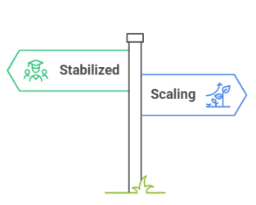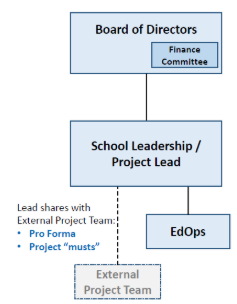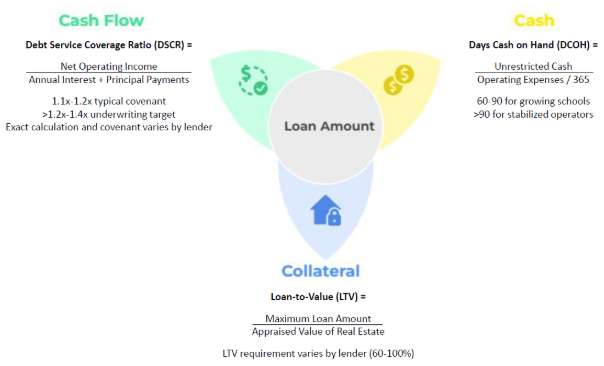Eight Keys to Success for Your Next Charter School Facilities Project
Facilities decisions are among the most complex and high-stakes choices a school will face. Whether you are entering into a new lease, buying or renovating a building, or refinancing debt, these decisions have a lasting impact, determining a material portion of your operating budget for years to come.
At EdOps, we know facilities decisions deserve outsized attention and careful planning. On November 13, 2025, we hosted an EdOps Lab, "Facilities Project Readiness: Building the Foundation for Success," to provide a framework for school leaders as they begin the critical project planning stage. Here are the key takeaways every school leader should know.
1. Start with Your Strategic Vision
It is difficult to get short-term decisions right without a clear long-term programmatic vision. This long-term vision acts as the "north star" throughout the facility decision-making process. Before you even look at properties, align internally on why a facilities decision is needed. Is your school scaling, or has it stabilized? Your program priorities must be the force that drives the facilities plan, not the other way around.
2. Plan (at Least) Two Years Ahead
Successful projects do not happen overnight. We strongly recommend that schools begin planning at least two years in advance of any major facilities decision. During this planning phase, build community support, cash, and cash flow to provide leverage for future negotiations and use this time to build the financial road map for your project.
3. Build your “Business Plan in Numbers”
The operating pro forma is your single most important tool in this process; it is your business plan in numbers. This multi-year budget is used to estimate the cash flow available for facilities expenses. This is not a "check the box" exercise. Your pro forma:
Defines program priorities and assesses affordability
Projects cash flow based on key inputs like enrollment, staffing, and funding
Identifies the net revenues available for facilities expenses each year
Models liquidity, showing how cash on hand will be impacted by a facilities decision
4. Know Your Goal: Long-Term Sustainability
The ultimate goal is not just to secure a building. The goal is to ensure your facilities expenses are sustainable once your school reaches its stabilized enrollment. You must be able to maintain compliance with your lease or loan without compromising your core academic program priorities.
5. Assemble Your Internal and External Project Team
You cannot do this alone. Success requires clearly defined roles for both internal and external team members.
Internal Team: Your Board of Directors sets the long-term vision, and the Finance Committee reviews and provides facilities recommendations to the Board. Build in plenty of time for the Committee’s processing and questions. Identify a school-level Project Lead to serve as a bridge between the board and external team. EdOps as your outsourced business partner creates the pro forma with leadership inputs and EdOps Facilities Support Team is available to perform loan, lease or other scenario analysis, if desired.
External Team: Engage external partners who have experience supporting schools with similar projects. This team will always include an attorney (engage early!) and may include a real estate broker, financial or municipal advisor, and a project manager that oversees the architect and general contractor if you undertake construction.
6. Budget for All Project Costs
Your project budget must include far more than just the "hard" (construction) costs. A realistic budget must account for:
Soft Costs: These typically run 15-20% of hard costs and include fees for your architect, engineer, and project manager.
Transaction Costs: If you're seeking a loan, these can be 3-5% of the loan amount depending on the financing source.
Other Costs: Don't forget furniture, moving expenses, legal fees, and permitting.
Contingency:Build contingency of ~5% for soft costs and ~10% for hard costs to absorb the unexpected.
7. Understand What Lenders Look For
If your project requires financing, understand the key financial metrics lenders will use to assess your school's health and size a loan.
Debt Service Coverage Ratio: Your ability to cover annual debt payments with your net operating income.
Days of Cash on Hand: Your unrestricted cash reserves, or liquidity.
Loan-to-Value: The ratio of the loan amount to the appraised value of the property.
8. Plan to Close the Gaps
What happens if your pro forma shows a financial gap after layering in facilities costs? The first step is to determine if that gap is temporary (only during your scaling period) or structural (exists even at stabilization).
Your project team can explore a range of strategies to close that gap, such as:
Value engineering (reducing project costs).
Phasing or delaying the project until enrollment increases and cash flow improves.
Fundraising to reduce reliance on debt.
Securing additional collateral or subordinate debt to improve loan terms.
A major facilities project is a journey. By starting with a clear vision, building a data-driven pro forma, and assembling an experienced team, you can build a foundation for success.
If you’d like to discuss your school’s facilities plans, please contact Molly Melloh (Molly@ed-ops.com) or Jane Skalski Mattson (Jane@ed-ops.com).





